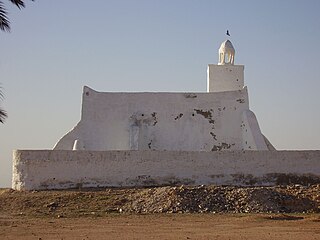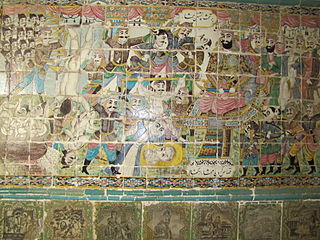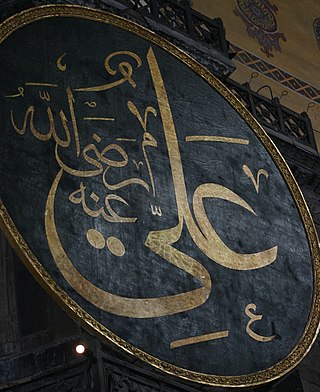
Abu al-Abbas Abd Allah ibn Muhammad ibn Ali ibn Abd Allah, known by his laqab al-Saffah, was the first caliph of the Abbasid Caliphate, one of the longest and most important caliphates in Islamic history.

Husayn ibn Ali ibn Abi Talib was a prominent early Islamic figure. He was a grandson of the Islamic prophet Muhammad and a son of Ali ibn Abi Talib and Muhammad's daughter Fatima, as well as a younger brother of Hasan ibn Ali. He is regarded as the third Imam in Shia Islam after his brother, Hasan, and before his son, Ali ibn Husayn Zayn al-Abidin. Being a grandson of the prophet, he is a member of the Ahl al-Bayt. He is also considered to be a member of the Ahl al-Kisa, and a participant in the event of Mubahala. Muhammad described him and his brother, Hasan, as the leaders of the youth of Paradise.

The Battle of Karbala was fought on 10 October 680 between the army of the second Umayyad caliph Yazid I and a small army led by Husayn ibn Ali, the grandson of the Islamic prophet Muhammad, at Karbala, Sawad.
Zayd ibn ʿAlī, also spelled Zaid, was the son of Ali ibn al-Husayn Zayn al-Abidin, and great-grandson of Ali ibn Abi Talib. He led an unsuccessful revolt against the Umayyad Caliphate, in which he died. The event gave rise to the Zaydiyya sect of Shia Islam, which holds him as the next Imam after his father Ali ibn al-Husayn Zayn al-Abidin. Zayd ibn Ali is also seen as a major religious figure by many Sunnis and was supported by the prominent Sunni jurist, Abu Hanifa, who issued a fatwa in support of Zayd against the Umayyads.
Zaydism is one of the three main branches of Shia Islam that emerged in the eighth century following Zayd ibn Ali‘s unsuccessful rebellion against the Umayyad Caliphate. Zaydism is typically considered to be a branch of Shia Islam that comes closest to the Sunni, although the "classical" form of Zaydism over the centuries had changed its posture with regard to Sunni and Shia traditions multiple times, to the point where interpretation of Zaydi as Shia is often based on just their acceptance of Ali as a rightful successor to Muhammad. Zaydis regard the rationalism as more important than Quranic literalism and in the past were quite tolerant towards Sunni Shafiism, a religion of about half of the Yemenis.

Muhammad ibn Ali al-Baqir was the fifth imam in Shia Islam, succeeding his father, Zayn al-Abidin, and succeeded by his son, Ja'far al-Sadiq. His mother, Fatima Umm Abd Allah, was the daughter of Hasan, making al-Baqir the first Imam who descended from both grandsons of Muhammad, namely, Hasan and Husayn.

The Ibadi movement or Ibadism is a branch of Islam. It has been called by some the third branch of Islam, along with Sunni Islam and Shia Islam. The followers of Ibadism are known as the Ibadis.

Ali ibn al-Husayn al-Sajjad, also known as Zayn al-Abidin, was the great-grandson of the Islamic prophet Muhammad, and an imam in Shia Islam, succeeding his father, Husayn ibn Ali, his uncle, Hasan ibn Ali, and his grandfather, Ali ibn Abi Talib.
Sa'id ibn Jubayr (665–714), also known as Abū Muhammad, was originally from Kufa, in modern-day Iraq. He was regarded as one of the leading members of the Tabi'in. Sa'īd is held in the highest esteem by scholars of the Shi'a and Sunni Islamic tradition and was considered one of the leading jurists of the time. He also narrated several hadith from Ibn Abbas.

Al-Abbas ibn Ali ibn Abi Talib, also known as Abu al-Fadl, was a son of Ali ibn Abi Talib, the fourth caliph in Sunni Islam and the first imam in Shia Islam. His mother was Fatima bint Hizam, commonly known as Umm al-Banin. Abbas fought as the standard-bearer of his half-brother Husayn ibn Ali in the Battle of Karbala on 10 Muharram 61 AH against the army of the Umayyad caliph Yazid ibn Mu'awiya. He was killed in a desperate attempt to bring water from the Euphrates river to quench the unbearable thirst of the besieged family of the Islamic prophet Muhammad. Abbas is said to have inherited Ali's boldness and bravery, and was praised by Shia imams for his faith and fortitude in defending Husayn. Abbas is regarded by Shia Muslims as an ultimate paragon of courage and self-sacrifice. The shrine of Abbas and the nearby mausoleum of Husayn in Karbala are destinations for pilgrimage.

Muhammad ibn Abi Bakr ibn Abi Quhafa al-Taymi was an Arab Muslim commander in the service of the fourth Rashidun caliph Ali.
Muslim ibn Aqil al-Hashimi was a relative of the Islamic prophet Muhammad. Muslim was the son of Aqil ibn Abi Talib and a cousin of Husayn ibn Ali, the third Shia Imam, who dispatched him to Kufa in Iraq to ascertain their support upon the accession of the Umayyad caliph Yazid. The Kufans welcomed Muslim and overwhelmingly pledged to support Husayn against the Umayyad rule, which they considered illegitimate and tyrannical. In response, Yazid replaced the mild governor of the city with his strongman Ubayd-Allah ibn Ziyad, who soon discovered the hideout of Muslim through an informant. When Ibn Ziyad imprisoned or killed Hani ibn Urwa, who was secretly sheltering Muslim, he came out in open revolt and surrounded the governor's palace with his supporters in September 680 CE. With a combination of threats and promises, however, Ibn Ziyad induced Kufan tribal leaders to abandon Muslim and withdraw their men. A deserted Muslim was arrested after a strong resistance and executed. Before this turn of events, he had written to Husayn and urged him to come to Kufa. Husayn thus left Mecca with his family and a few supporters, but his caravan was intercepted and massacred by the Umayyad forces in October 680 in Karbala, near Kufa. Muslim is revered in Shia Islam for his bravery and moral uprightness. His shrine in Kufa is a destination for Shia pilgrims.

Al-Mukhtar ibn Abi Ubayd al-Thaqafi was a pro-Alid revolutionary based in Kufa, who led a rebellion against the Umayyad Caliphate in 685 and ruled over most of Iraq for eighteen months during the Second Fitna.

Muhammad ibn al-Hanafiyya was a son of Ali ibn Abi Talib, who was the fourth caliph in Sunni Islam and the first imam in Shia Islam. Ibn al-Hanafiyya was an effective lieutenant for his father Ali during his caliphate. After the assassination of Ali and the deaths of his two sons Hasan and Husayn, many recognized Ibn al-Hanafiyya as the head of the House of Ali. Claiming to represent Ibn al-Hanafiyya, Mukhtar al-Thaqafi rose in Iraq in 686 to avenge Husayn and his relatives, who were massacred in 680 CE by forces of the Umayyad caliph Yazid bin Mu'awiya. The quiescent Ibn al-Hanafiyya did not actively associate with this rebellion but was still rescued by Mukhtar when he was detained by the rival caliph Ubayd Allah ibn Ziyad. Support for Ibn al-Hanafiyya continued even after the defeat and death of Mukhtar in 686–687 in the form of the Kaysanites, a now-extinct Shia sect that traced the imamate to Ibn al-Hanafiyya and his descendants, particularly his son Abu Hashim. After the death of Ibn al-Hanafiyya in 700–701, some Kaysanites declared that he was the Mahdi, the eschatological Islamic leader who would reappear in the end of time and eradicate injustice and evil. The Kaysanites later provided the organizational structure for the Abbasids to overthrew the Umayyads in 750–751.
The Hashemite–Umayyad rivalry was a feud between the clans of Banu Hashim and Banu Umayya, both belonging to the Meccan Arab tribe of Quraysh, in the 7th and 8th centuries. The rivalry is important as it influenced key events in the course of early Islamic history.
Abu Muhammad Hasan ibn Hasan ibn Ali al-Hashimi was an Islamic scholar and theologian. He was a son of Hasan ibn Ali and Khawla bint Manzur. He was a grandson of the fourth caliph Ali and a great-grandson of the Islamic prophet Muhammad.
Abū Muḥammad ʿAbd Allāh ibn al-Ḥasan ibn al-Ḥasan ibn ʿAlī ibn Abī Ṭālib al-Hāshimī al-Qurashī (Arabic: أبو محمد عبد الله بن الحسن بن الحسن بن علي بن أبي طالب الهاشمي القرشي; c. 690 – 762, better known as ʿAbd Allāh al-Maḥḍ and ʿAbd Allāh al-Kāmil, was an Islamic scholar, theologian and hadith narrator, grandson of both Hasan ibn Ali and Husayn ibn Ali. His sons include Muhammad and Ibrahim, who rebelled against Abbasid rule, and Idris, who rebelled in the Maghreb and established the Idrisid dynasty.

Yahya ibn Zayd was the eldest son of Zayd ibn Ali, the founder of the Zaydi movement. He participated in the unsuccessful revolt against the Umayyad Caliphate launched by his father in 739/40, and escaped to Khurasan, where he tried with limited success to gain support for another rebellion. In 743 he was tracked down and finally killed by forces of the Umayyad governor, Nasr ibn Sayyar.
In Zaydi Islam, the imamate is the supreme political and religious leadership position. In common to other Shi'a sects, it is reserved for Alids, i.e. descendants of Muhammad via Ali ibn Abi Talib and Fatimah. Unlike the Twelver or Isma'ili imamate, however, it was not hereditary and could be claimed by any qualified Alid; necessary qualifications were a grounding in Islamic jurisprudence and a public call to allegiance, usually in the form of leadership of an uprising against unlawful authority. In practice, this meant that there could be several Zaydi imams at the same time, even in the same region, or none at all, rendering the Zaydi states established in Yemen and Tabaristan unstable. As a result, the imamate came to be passed down in hereditary fashion, especially as the Imams of Yemen abandoned Zaydi doctrines for Sunni ones in the 18th century.











